

Minolta's Meters
Most of Minolta's cameras, from large 35mm SLR to tiny 16mm, have meters built into them. Some had accessory meters that could be attached to the exterior of the camera. But for meterless cameras, and for special situations, Minolta made a wide range of hand-held meters that are stellar performers. These meters were not only targeted at the Minolta crowd. Their audience was the professional photographer, most of whom use medium and large format camera equipment. Many of the features and accessories of Minolta's hand-held meters are designed for these types of cameras.
When Minolta merged with Konica in 2003, they continued to make and sell hand-held meters, but they sold the rights to these products to Kenko. As a result, some of the meters listed here -- starting with the Auto Meter IV -- can also be found with the Kenko label. Similarly, Konica/Minolta sold its photographic division to Sony in 2006, and Sony's DSLR line of a-mount (Alpha/Maxxum/Dynax) cameras continued the production of newer DSLR cameras.
Light -- to understand hand-held meters, you have to understand a little about the natural of measuring light.
|
METER/ |
CELL TYPE AMBIENT: ANGLE/SENSITIVITY FLASH: ANGLE/SENSITIVITY BATTERY |
ISO-RANGE F-STOP-RANGE SPEED-RANGES AMBIENT FLASH |
||
|
Super A |
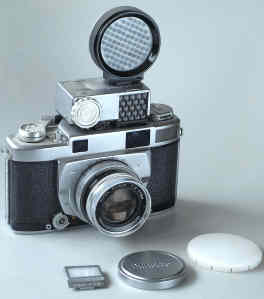 |
selenium 180° EV ? to ? -- -- -- |
ISO 10 to 1600 f? to ? 1s to 1/400 -- |
Minolta developed this meter as a clip-on accessory for their unmetered Super A camera of 1957. It attached to the flash shoe and couples to the shutter speed dial -- which is on the top of the camera. This provides metered-manual exposure control -- the first Japanese camera to have this feature. You dial in the film speed into the meter (10-1600) and then select the desired f-stop on the lens. Then, on the meter, you turn the dial on the front to match the meter's needle to the same f-stop -- and the correct shutter speed is "automatically" selected. The meter can even be removed from the camera and used on its own. There were three accessories for this accessory meter. The first is a simple, clip-on incident light panel. More interesting is the meter "booster". The meter has a shoe on the top that can hold a flash unit -- or a round, meter amplifier. This increases the sensitivity of the meter by a factor of FOUR and is great for low-light situations! The last accessory is an accessory for the accessory booster. It is a round, flat, clip-on incident cap. |
|
SR |
 |
selenium 180° EV 5 to 18 -- -- -- |
ISO 6 to 3200 f1.4 to 22.0 1s to 1/1000 -- |
Minolta developed this meter as a clip-on accessory for the SR-3 camera of 1960. It can also be used on the model d and e versions of the SR-1. It clipped on to the top of the shutter speed dial and was very easy to use. First, dial in the film speed on the meter, and then select a shutter speed. As you select a shutter speed on the meter, the same speed is set on the camera. Next, point the meter toward the scene and read the correct f-stop on the top of the meter. Set that f-stop on the lens, and take the picture. (Alternately, the f-stop could be selected first and then the shutter speed dial turned until the needle in the meter readout points to the same f-stop.) This process was so convenient that Minolta actually called it "semi-automatic" exposure control back in those days! It was a process that Minolta had developed on the Super A camera of 1957 -- the first Japanese camera to offer this feature. Minolta should have used this feature on the SR-2 of 1958, but instead, Canon stole the idea and used it on the Canonflex of 1959 -- grabbing the thunder that rightfully belonged to Minolta. What's the lesson that we should learn from this? Expose first, and ask questions later! This meter has been seen in three "colors" -- chrome & black, all black, and chrome & grey. |
|
SR-2 |
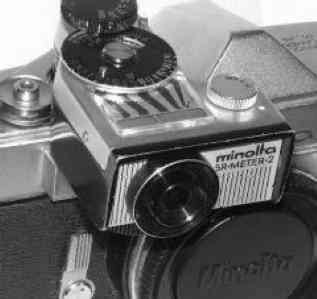 |
CDS 40° EV 2 to 18 -- -- 625 mercury |
ISO 6 to 3200 f1.4 to 22.0 1s to 1/1000 -- |
This was an updated version of the SR meter with a CDS cell. It was designed to operate with the SR-3 camera and the d and e models of the SR-1. It was much more sensitive in low light than the SR meter -- thanks to the CDS photocell -- but the basic operation of the meter was the same. The only drawback was a substantial increase in the size of the meter. Despite the name, this meter has nothing to do with the SR-2 camera, and cannot be used with it. It is merely the second generation of the SR meter, hence the name SR-2. The meter has a switch for "HIGH" and "LOW" ambient light settings on the top of the meter, and requires a battery. |
|
SR-V |
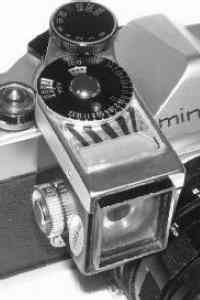 |
CDS 30° EV 2 to 18 -- -- 625 mercury |
ISO 6 to 6400 f1.4 to 22.0 1s to 1/500 -- |
The new V body of the SR-1 (model V) required a new meter because the shutter speed dial and the camera body size were changed. The meter features and operation were the same as those the SR-2 meter, but the SR-2 and SR-V meters are NOT interchageable. Minolta was able to make the SR-V meter substantially smaller in size than the SR-2 meter. The "HIGH" and a "LOW" ambient light switch is moved to the side of the meter. It has a battery check and an OFF setting. Besides the SR-1 (model V), this meter was useable on the later SR-1s, but the meter tops out at 1/500, while SR-1s has a 1/1000 top speed. |
|
View Meter 9 |
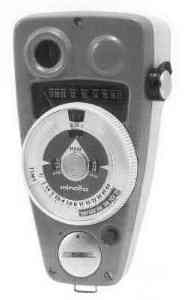 |
CDS 9° EV -3 to 20 -- -- A1PX |
ISO 6 to 25000 f1.0 to 64.0 2h to 1/8000 -- |
Minolta's first hand-held meter appeared the same year as the SRT101, a camera that had a built-in, TTL meter. In fact, most of Minolta's cameras, in 1966, had built-in or attachable meters, but spot-metering was the rage and none of Minolta's cameras had that. The name "View Meter", suggests that this meter was targeted at the non-Minolta crowd of large-format camera users. Who knows? Minolta never made a large-format camera, but these cameras are commonly referred to as "view cameras", and they require a hand-held meter. Minolta saw an opening in this market, and offered a product to meet the need. The "9" in the name refers to the 9 degree angle of acceptance. That's an odd number, but perhaps it was designed to beat-out other 10 degree meters on the market at that time. In use, the VM 9 was similar in many ways to other meters of the time. Point it at a scene, then press a button on the side. A needle on the scale points to an EV number. That EV number is then manually transferred to the meter's dials, and the meter displays a range of f-stop/shutter speed combinations that can be used on the camera. But what made the VM 9 stand out was that it is shaped to fit the hand comfortably, and the metering button falls under the thumb perfectly. It feels like an extension of your hand. The VM 9 has a CDS cell which requires the use of high- and low-light scales on the meter, but otherwise it is very easy to use and comfortable to hold. The VM 9 is on the large and heavy side, by today's standards, but it is very sensitive, and has wide-ranging scales -- f-stops 1.0 to 64, ISO 6 to 25,000 and shutter speeds from 2 hours to 1/8,000! It was obviously designed for long-term use since no cameras at the time -- or today -- have a 1/8,000 shutter speed. Very few of today's meters can top that. But at the time, photography was in a great state of flux, and no one knew what the future might hold. The VM 9 is still very useable today -- as long as you can find an A1PX battery (the owner's manual says it takes a PX13 battery, but that's wrong) -- and a very easy way to move into spot metering. No accessories were available, except for the super-soft, form-fitting, leather pouch and neck strap that came with the meter. The meter has a battery check built in. |
|
SR-S |
 |
CDS 40° EV -- -- 625 mercury |
ISO 6 to 3200 f1.4 to 22.0 1s to 1/1000 -- |
An updated version of the SR-V meter that was designed for the SR-1s camera. It was changed to accomodate the 1/1000 second shutter speed of the SR-1s camera. The features and operation of the meter remained the same as those of the SR-V. |
|
Auto Spot 1 |
 |
CDS 1° EV 3 to 17 -- -- 1 * AA (to illuminate scale) + 1 * 9 volt |
ISO 3 to 25000 30s to 1/2000 -- |
Minolta's first ultra-spot meter instantly became popular, not so much with Minolta camera users, but with advocates of the Zone system using larger format cameras. Using this meter was the equivalent of metering a scene with a 2000mm lens attached to a 35mm camera. It was large, heavy and expensive, but accepted filters, had a focusing lens, and had a circular readout in the viewfinder which showed a full range of usable f-stop/shutter speed combinations -- automatically! No need to match needles or dial in anything (other than the film speed). That's the "auto" in "Auto-Spot". The meter has an SLR design so what you see is what you get. The angle of view is 8 degrees -- so it's easy to find your subject -- but the meter only responds to the central 1 degree portion. The viewfinder has built-in adjustable dioper control -- from -5.2 to +1.7 -- for easy use without glasses. Built-in battery check, illuminating lamp in the viewfinder (for dark situations), and 52mm filter thread -- for easy use with any filter. It also sports a sturdy wrist-strap which screws into the handy tripod socket on the bottom of the handle. It came with an ISO-DIN converter on the bottom of the handle and a 52mm 16X neutral density filter for very bright situations. The lens focuses to 3.3 feet, but the distance is not marked in any way. The viewfinder is very bright which makes focusing on the clear fresnel screen a breeze. It came with a collapsible, rubber lenshade, lens cap, and a large felt-lined, leather case. To operate the meter, the ISO is dialed in with a knob on the front of the meter. Then the subject is selected and a button (which naturally falls under the index finger) is pressed. What could be easier? The Auto Spot 1 helped to make Minolta a major player in the photographic meter market, when Pentax, Soligor, and others were producing similar products. All you had to do was figure out what you wanted to meter in the scene. Accessories included a 4X neutral-density filter, soft case, deluxe case, and a rubber lens shade. |
|
Flash Meter |
 |
SILICON I,40°,10° EV 3 to 10 I,40°,10° EV 3 to 10 1 * AA (to illuminate scale) + 5 * 625 mercury |
ISO 12 to 1600 f1.0 to 128 1/30 to 1/250 1/30 to 1/250 |
Really a misnomer, the Flash Meter reads light from electronic flsh units, but it also reads ambient light,
as well. It has numerous unique accessories that are similar, but cannot be used on the other meters. Accessories
included a connecting cord (to connect the meter and the flash), an accessory cord (to connect the camera, flash
and meter at the same time, soft case (for the meter), deluxe case (for the system), 4X neutral-density filter,
10 degree spot attachement, 4X neutral-density filter for the spot attachement, domed incident disc, flat incident
disc, pinpoint receptor, micro-disc receptor 1-H, and micro-disc receptor 2-H. This meter is designed to work with
five mercury battereies, but will work correctly with five 625 alkaline batteries due to its silicone cell. It
is most often seen as a kit with its accessories and its own special system case. |
|
Color Meter |
 |
SILICON C EV 2 to 15.5 -- -- 5 * 625 mercury |
-- -- -- -- |
Most color meters at the time used only two photo cells and just measured one spectrum of light. Others used rotaing filters over the cells which required taking several readings of the scene. Minolta's Color Meter had four cells and read two spectrums of light without having to change filters. Accessories included a case ad a neck strap. |
|
Auto Meter |
 |
CDS I,40°,10° -- |
ISO f |
This was Minolta's first system meter. Like the Auto-Spot 1, it's motorized scale provided one-hand operation. That's the "Auto" in Auto Meter. Meters from other companies required one hand to hold the meter and another to turn dials and knobs. Not the Auto Meter Pro. Just pick up the meter and press the button that naturally falls under your thumb. The meter's motor does the rest. It was usable for incident and reflected light, as well as average and spot readings. Interchangeable attachments screw into the rotating meter head. The CDS meter is very sensitive but requires Low and High scales. This approach is easy to use -- lights on the front of the meter indicate when you need to switch. Another switch on the back chooses incident or reflected readings. The meter has a battery check and conversion scales on the back. Accessories included a pinpoint probe, enlarger mask, flat diffuser, 10 degree spot attachment, spherical diffuser, case for meter, and special case when the spot attachment is used. |
|
Flash Meter II |
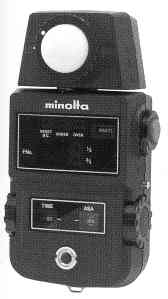 |
SILICON I,40°,10°,5° EV 3 to 20 I,40°,10°,5° EV 3 to 20 1 * 9 volt |
ISO 12 to 3200 f1.0 to 90.0 1s to 1/250 1s to 1/250 |
The Flash Meter II opened a whole new approach to metering. It's large, but lightweight, and much more versatile than the original Flash Meter. It is limited in its ability to read low ambient light, but can adequately cover normal situations with normal camera settings. Like the original Flash Meter, you dial in the shutter speed you want to use. But on this model, the f-stop is displayed on an LED panel, instead of a needle. The LED panel displays whole f-stops only. That is, it displays 5.6, but not 6.0. And it's a good thing, as Martha Stewart says, since f6.0 would just confuse many people. Is f6.0 the half-way point between f5.6 and f8? If not, how do you dial in f6.0? So for intemediate stops, the Flash Meter II has two additional LEDs next to the whole f-stop that indicate 1/3 and 2/3 increments over the whole f-stop. This is odd since Minolta lenses have 1/2 stop increments. This LED approach has its advocates and detractors. The Flash Meter II offers new metering modes, but why they called it "Flash Meter", I'll never know. Sure, it reads flash, but many people assume that it is useless with ambient light. Not true. It is an adequate ambient light reader, but it reads flash light as well. It even will read both flash and ambient light at the same time. Accessories included a 40 degree reflected light attachement, spherical diffuser, soft case, shoulder strap, 10 degree spot attachement, spherical incident disc, close-up probe, neutral density spherical diffuser, and the handy Synchro Cord II -- to connect the camera, flash, and meter. |
|
Auto Spot II |
 |
SILICON 1° EV 3 to 17 -- -- 1 * 9 volt |
ISO 3 to 25000 f1.0 to 45.0 30s to 1/2000 -- |
This version is much smaller and lighter than the original, but operates in a very similar fashion. The viewfinder has rotating scales around the circular viewfinder indicating EV levels and usable f-stops and shutter speed combinations. Many consider this model to be the best spot meter you can get. Accessories included a case, hand strap, neutral density filter, lens cap, and rubber lens hood. |
|
Auto Spot II DIGITAL |
 |
SILICON 1° EV 1 to 20 -- -- 1 * 9 volt |
ISO 12 to 6400 f1.0 to 90.0 15s to 1/2000 -- |
The Auto Spot II digital uses the same body as the Auto Spot II, but instead of a full EV/f-stop/shutter speed display in the viewfinder, it just displays the EV number in the viewfinder. On the exterior of the meter is an LED panel that displays the f-stop, but it shows only one f-stop at a time -- after you dial in the shutter speed you want to use. This is just like the Flash Meter II display. There are two additional LEDs next to the whole f-stop that indicate 1/3 and 2/3 increments over the whole f-stop. Some like it, but others prefer spot meters that display the full range of f-stop/shutter speed combinations. Accessories included a case, hand strap, lens cap, and rubber lens hood. |
|
Auto Meter II |
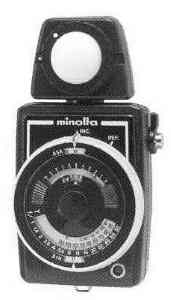 |
SILICON I,40°,10°,5° EV -4 to 17 -- -- 1 * 544 |
ISO 6 to 25000 f1.0 to 90.0 2h to 1/8000 -- |
The Auto Meter II uses the body of the Auto Meter Professional, but makes some major improvements. Most importantly, the Auto Meter II uses a silicon cell. While this only increases the sensitivity a little, it makes the meter easier to use. The low/high scales are gone, and the Incident-Reflectance switch is moved to the front. The screw-in attachments are replaced with bayonet attachments. The meter has a lock to prevent accidental operation, but the use of the meter is the same as its predecessor. The 5° attachment was not designed for this meter, but it will fit and work -- with a 4X ISO adjustment. With its low-light capabilities (the best of any Minolta meter) and motorized control, the Auto Meter II can't be beat -- unless you need flash, spot, or color temperature readings. This was Minolta's last meter to offer a full-scale display where all of the f-stop/shutter speed combinations are displayed at once. After this, you need to spend time picking a shutter speed on the meter, and then the meter will indicate the f-stop. So much for "progress"! You want the most sensitive and easiest to use meter? This is the one to get. Accessories included a close-up probe, enlarger mask, flat diffuser, 10 degree spot attachment, spherical diffuser, 4X neutral density diffuser, 8X neutral density diffuser, case for meter, and neck strap. |
|
Booster |
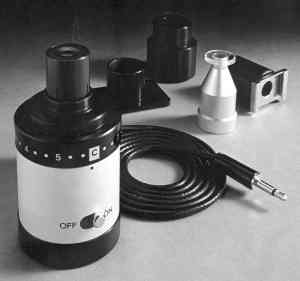 |
SILICON 60° varies w/ meter 60° varies w/ meter 1 * 544 |
-- -- -- -- |
The Minolta Booster is a special meter attachment that is really a meter in itself. It provides extra sensitivity to meters and allows meters to take readings in unusual ways. It attaches to select meters with a special plug on the meter's head. It can be used without any attachments for 60° reflectance readings, or it can be used with any of its four attachments for special readings:
|
|
Flash Meter III |
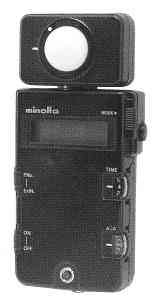 |
SILICON I,40°,10°,5° 6 * S76 |
ISO 12 to 3200 f1.0 to 90.0 30s to 1/1000 1s to 1/250 |
Seen with both the old and new Minolta logo. |
|
Color Meter II |
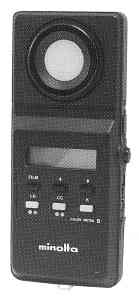 |
SILICON C EV 2 to ? -- -- 1 * 9 volt |
-- -- -- -- |
|
|
Auto Meter III |
 |
SILICON I,40°,10°,5° EV -2 to 19.5 -- -- 1 * AA |
ISO 12 to 6400 30m to 1/2000 -- |
The Auto Meter II gave way to the Auto Meter III with a new LCD readout. It sports some new features that the Auto Meter II lacks, such as a memory which can store two meter readings, but the Auto Meter III lacks the full f-stop/shutter speed/EV/cine scale of the Auto Meter II. With the Auto Meter III, it's necessary to select the shutter speed you want to use. Then the meter displays an f-stop. The one-hand operation of the Auto Meter II is gone. To change shutter speeds, a button needs to be pressed. To see the EV number, a different button is pressed. A power-saving feature turns off the power-sucking display after two minutes. To get it back, another button must be pressed. I hope you have a good, fast memory for all of those button operations! The Auto Meter III uses the same accessories as the Auto Meter II. Seen with both the old and new Minolta logo. |
|
Spot Meter M |
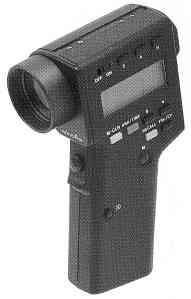 |
SILICON 1° EV 1 to 22.5 -- -- 1 * AA |
ISO 12 to 6400 30m to 1/2000 -- |
An even smaller spot meter. The Spot Meter M lets you take 1° spot measurements of ambient light. Liquid crystal displays on the meter's side panel and in the viewfinder show exposure information in both digital and analog form. Exposure calculations for highlights, shadows, or mid-tone areas can be made at the touch of a button. Plus, the lighting contrast can be quickly checked while looking through the viewfinder. The Spot Meter M can automatically calculate the exposure for highlight or shadow areas. And, by using the memory function, the user can average two readings for a mid-tone exposure. Exposure readings are shown digitally in the meter's data panel and viewfinder displays. The data panel also has an analog f/number scale that can indicate up to four exposure readings. When the Spot Meter M is switched off, the ISO and shutter speed settings are stored in memory. When the meter is switched back on, the most recent digital exposure readout and any memorized data is displayed. |
|
Auto Meter IIIF |
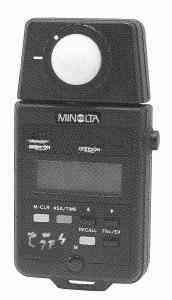 |
SILICON I,40°,10°,5° EV -2.4 to 19.1 I,40°,10°,5° EV 1 * 544 |
ISO 30m to 1/2000 1/60 and 1/250 |
The Auto Meter IIIF has the same body, features, and accessories as the Auto Meter III, but adds flash metering. |
|
Spot Meter F |
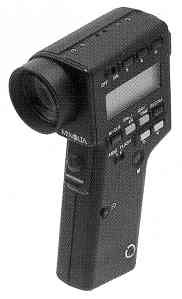 |
SILICON 1° EV 1 to 22.5 1° EV 1 * AA |
ISO 12 to 6400 30m to 1/2000 1s to 1/1000 |
This model offered a new option in spot metering -- flash readings. Minolta thought -- for some reason -- that spot metering needed a flash option. Or that flash metering neded a spot option. Who knows. But the idea never sold. Most spot meter readers, don't use flash, and most flash users don't need a spot. So Minolta missed the boat on this meter. But who knows? Maybe there are people out there that need a flash meter that reads the light on someone's nose hairs. The Spot Meter F lets you take 1° spot measurements of ambient or flash light. Liquid crystal displays on the meter's side panel and in the viewfinder show exposure information in both digital and analog form. Exposure calculations for highlights, shadows, or mid-tone areas can be made at the touch of a button. Plus, the lighting contrast can be quickly checked while looking through the viewfinder. The Spot Meter F can automatically calculate the exposure for highlight or shadow areas. And, by using the memory function, the user can average two readings for a mid-tone exposure. Exposure readings are shown digitally in the meter's data panel and viewfinder displays. The data panel also has an analog f/number scale that can indicate up to four exposure readings. When the Spot Meter F is switched off, the ISO and shutter speed settings are stored in memory. When the meter is switched back on, the most recent digital exposure readout and any memorized data is displayed. |
|
Booster II |
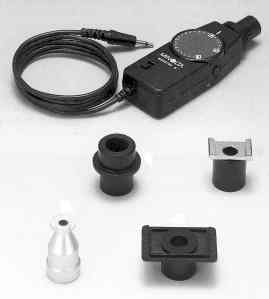 |
SILICON 60° varies w/ meter 60° varies w/ meter 1 * 544 |
-- -- -- -- |
The Minolta Booster II is an updated version of the earlier Booster. The features are the same as the original, but the Booster II comes in a longer, flat, black body and has an extra button that you can use when you want to take a reading. It keeps the meter on for only 10 seconds and then turns the meter off in order to safe battery life -- nice touch. The regular ON/OFF button can be used -- if you happen to own stock in Duracell or can't manage to take an exposure reading in ten seconds. Like its predecessor, it provides extra sensitivity to meters and allows meters to take readings in unusual ways. It attaches to select meters with a special plug on the meter's head. It can be used without any attachments for 60° reflectance readings, or it can be used with any of its four attachments for special readings:
|
|
Flash Meter IV |
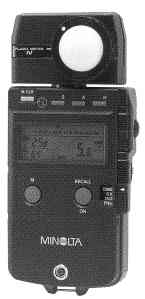 |
SILICON I,40°,10°,5° EV -2 to 19.5 I,40°,10°,5° EV 1 * AA |
ISO 8 to 6400 30m to 1/8000 30m to 1/8000 |
The Flash Meter IV is an update of the Flash Meter III. This unit offers more memory functions enabling it to compare
multiple measurements to get a more accurate reading in complex lighting environments. The meter is also compatible
with many of the accessories from the previous Flash Meter III. A new accessory to this meter is called DR-1000.
The DR-1000 is an accessory for certain Minolta Maxxum cameras that enables the Flash Meter IV to send metering
data via IR to those cameras by pressing the "Data out" button on the back of the meter. Along with the
standard AA battery used to operate the meter, this feature requires an additional 6v 5LR44 battery. A calibration
adjustment can also be made from -0.08 to +0.07, this is useful when using multiple meters. A tripod socket is
also provided. There are so many features in this meter, you need to keep the user manual handy! |
|
Auto Meter IV F |
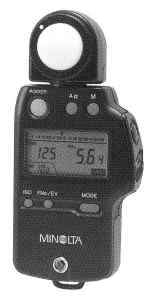 |
SILICON I,40°,10°,5° EV 7.8-31.5 I,40°,10°,5° EV 7.7-31.5 |
ISO 3 to 8000 f1-90 30m to 1/8000 1s to 1/500 |
Like the Auto Meter IIIF but intensely redesigned body.
|
|
Flash Meter V |
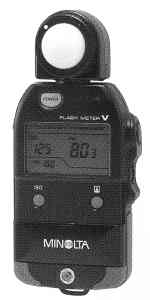 |
SILICON I,40°,10°,5° EV -2 to 22.5 I,40°,10°,5° EV -2 to 22.5 1 * AA |
ISO 3 to 8000 30m to 1/16000 30m to 1/1000 |
The Minolta Flashmeter V's intelligent AUTO mode measures ambient, flash, or mixed ambient and flash light. In addition, it provides exposure analysis for flash measurements, showing the ratio of flash light to overall exposure. Other easy-to-use functions include: Brightness difference function for adjusting lighting balance; memory with analog scale for previsualizing results by measuring multiple points; calculation functions for averaging stored measurements or biasing exposure readings for shadows or highlights; instant-film ISO button for taking measurements for test exposures without resetting the ISO. Plus an easy-to-read data panel, positive-action up/down dial and a sliding cover that hides less often-used buttons. |
|
Color Meter III F |
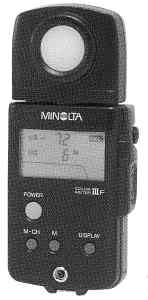 |
SILICON C EV C EV |
ISO -- f2.8 to 180.0 -- 1s to 1/1000 |
The Minolta Color Meter IIIF is a color compensation meter for ambient and flash with correction value memory. This makes it easier for photographers to maintain consistent color under various types of illumination. The meter measures the color of the light illuminating the subject and determines the filtration required to correct that illumination for the film in use. When measuring both ambient light and flash, selecting the Color Meter IIIF's analyzing function will subtract the ambient light and display only the measured results for flash light. Measurements can be taken for any of the three major film types: Daylight (balanced to 5500k), Type-A Tungsten (balanced to 3400k), or Type-B Tungsten (balanced : to 3200k). Measurement results can be displayed as light-balancing and color compensating indexes, Kodak Wratten filter number and CC index, or photographic color temperature (determined color temperature based on film sensitivity). Display of Kodak Wratten filter numbers makes selecting filters quick and convenient; if 2 Wratten filters are necessary, the Color Meter IIIF displays both numbers. Color Meter IIIF users can store their own personal correction values for the recommended filtration. Correction values for LB and CC indexes can be stored in any of the meter's nine memory channels to custom-tune meter readings for the desired color reproduction. The correction values are added to the initial measured values to calculate the final displayed results. |
|
Auto Meter VF |
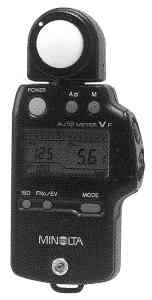 |
SILICON I,40°,10°,5° EV -2 to 24.4 I,40°,10°,5° EV -2 to 24.4 1 * AA |
ISO 3 to 8000 30m to 1/8000 1s to 1/500 |
Using the same body as the Auto Meter IV F, the Auto Meter VF measures ambient light and flash with or without a sync cord. In all measuring modes, with reflected or incident readings, it is a very reliable meter. It stores and averages two separate readings making it easy to determine subject contrast range or lighting ratio. It can calculate the ratio of flash light to ambient light in relation to the total illumination. Whenever you take a flash light reading, the Analyze scale is displayed on the LCD data panel. After a reading, you can also do a simulation to see how changes to the shutter speed affect the proportions of ambient light and flash light. The analyze scale shows the proportion of flash light in the total exposure reading as one of five levels. In addition, several custom settings are possible. For cinematographers, the Auto Meter VF has ten framing rate settings. Plus, the extended ISO range can be used to factor in filtration correction. In addition to continuous ambient light measurement, the Minolta Auto Meter VF offers both CORD and NON-CORD modes for flash measurements. The display mode can be customized according to the users preference. The selectable shutter speed increment setting is 1-stop, 1/2-stop or 1/3-stop increments. The selectable f-stop display mode is the conventional intermediate stop display (1/10-stop increments) or the f-number direct-reading mode. In addition to the averaging function that determines an average exposure reading at any two points, the Minolta Auto Meter VF provides the shadow-based and highlight-based exposure calculation functions in reflected light measurement. With its built-in memory function, the easy to use Auto Meter VF can store up to two measured values in the memory, enabling lighting ratio and contrast on a subject to be easily confirmed. |
|
Flash Meter VI |
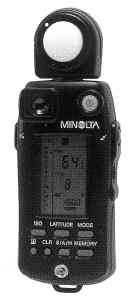 |
SILICON I,40°,10°,5° EV I,40°,10°,5° EV |
ISO 3 to 8000 f1.0 to 128.0 30m to 1/6000 30ms to 1/1000 |
The new Minolta Flash Meter VI incorporates a high-performance spot metering function with an acceptance angle of 1°. The Flash Meter VI not only operates as two different meters with a single unit, but it also displays the incident light and reflected light measurement results simultaneously and compares them by using the meters analog latitude display function. The built-in spot meter uses a compact, high-precision optical system to provide a bright view while maintaining the meters compact size. Additionally it features an easy to use diopter dial to ensure precise viewing and comfortable operation even for eyeglass wearers. Ensuring that the tonal range of the subject will be compatible with the final medium, i.e., film, printing ink, digital, television, etc., has long been a concern to knowledgeable photographers. The Flash Meter VI enables photographers to enter latitude of film or final medium and determine mid-tone standard (18-percent) using an incident reading. Once determined, the photographer can then measure the range of subject tones with the spot meter and use the Flash Meter VIs LCD analog display to determine if they will fit the latitude range and how they will be rendered in the final result. The latitude range based on the standard exposure measured by the flash meter (incident light measurement result) is displayed on the dot indicator of the analog scale. Simultaneously, the spot meters reading (reflected light measurement result) is displayed on a dot indicator of another analog-like scale. The user can visually check how each part of the subject is reproduced on the film by confirming the difference between the measured values for highlight and shadow areas on a subject and the standard exposure. With the Minolta Flash Meter VI, a user can easily determine the exposure suitable for an intended photographic image, because the exposure decision process can be instantaneously confirmed on the meters LCD panel. With a single, flash-ambient light measurement, the Flash Meter VI can display the ratios of both flash and ambient light on the meters LCD panel. The user can control the ratio of the flash illumination by changing the shutter speed setting, to produce the desired lighting effect according to the intended photographic image. The new Analyze quadrant display scale improves the visibility. With a push of the Memory key, the Flash Meter VI can store measurement data on up to 10 points. The Flash Meter VI displays the exposure difference between a predetermined standard value and the measured value for target points on the EV value display and the dot indicator of the analog display scale. According to the intended photographic image, the Flash Meter VI provides three types of exposure calculations - Shadow-based exposure, Average exposure and Highlight-based exposure. The display mode can be customized according to the users preference. The selectable shutter speed increment setting is 1-stop, 1/2-stopor 1/3-stopincrements. The selectable FNo. display mode is the conventional intermediate stop display (1/10-stop increments) or the f-number direct-reading mode. |
|
Illuminance Meters |
SILICON |
ISO -- -- -- |
Minolta also made, and still makes, a large number of illuminance, color temperature, and LUX meters, such as the T-1, LS-100, and T-10. These meters indicate light brightness levels instead of shutter speeds and f-stops. While they have many uses in industry, they are less useful with recreational photography. |
Meter Accessories:
lens shades, cases, ND filters
COPYRIGHT@1995-2019 by Joe McGloin.
All Rights Reserved.
The material on this website is protected by US Federal copyright laws. It cannot be copied or used in any manner
without specific approval from the owner.